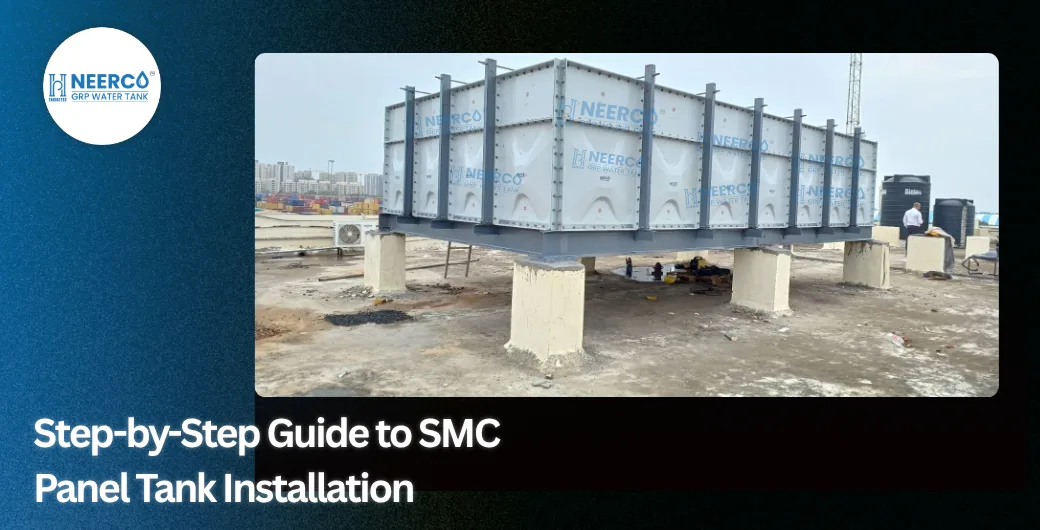


In the case of safe and effective water storage, SMC panel tanks are among the most trusted solutions utilized across industries, residential areas, and businesses. Their durable yet lightweight construction, modular design, and corrosion resistance make them a popular worldwide solution. For anyone looking for the latest alternative to the conventional water tank, SMC panel tanks are a top choice. But to guarantee long-term performance and safety, correct SMC panel tank installation is very important. Through this blog, we will walk you through an easy-to-follow step-by-step guide to installing an SMC panel tank correctly.
The most important component of any SMC panel tank installation is the foundation. An improperly prepared foundation can result in poor load distribution, leakage, or even tank structure failure.
A solid foundation will make the tank stable even under extreme weather conditions. Preparation of the foundation is important in the case of rust-proof GRP tanks and other long-lasting water storage equipment.
SMC tanks are prefabricated and consist of several panels that must be built on-site. Each panel is manufactured with care so they can fit together snugly.
Adequate positioning ensures the tank structure is stable and leak-free, one of the benefits of GRP water tanks being flexibility in construction.
Side panel fitting needs to be attended to with great care because this is where leaks tend to happen if sealed poorly. For those considering GRP against steel water tanks, correct sealing guarantees top-notch performance and longevity.
Internal supports in bigger tanks are important for shape and strength retention under heavy weights.
Excluding this step can undermine the durability and safety of the tank, which is extremely important for long-term water storage tanks employed in industrial or domestic use.
After installing the side walls and supports, roof panels are installed.
Roof panels keep the water stored inside safe from dust, debris, and exterior contamination.
Based on the design of the tank, roof hatches or inspection covers may also be provided for easy maintenance. This process indicates why SMC tanks are usually the best water tank for industrial and domestic consumption.
No water tank is complete without proper piping accessories.
Fit the inlet pipe for filling, the discharge outlet pipe, and an overflow pipe for safety.
These accessories turn the tank into a functional, safe, and easy-to-use one, supporting the advantages of GRP water tanks over normal tanks.
Before the tank is ready for operation, it needs to be tested.
Gradually fill the tank with water.
Testing will ensure that the SMC panel tank installation is successful and dependable, offering corrosion-resistant GRP tanks as a long-lasting storage solution.
Installation is only the first step,scheduled maintenance is necessary for keeping your SMC panel tank in prime condition.
Routine maintenance lengthens the lifespan of the tank and guarantees safe storage of water. Proper maintenance emphasizes the advantage in the contrast of water storage tanks, thereby making SMC panel tanks an optimal selection.
Searching for Professional SMC Tank Installation?
From corrosion-resistant GRP tanks to tanks for domestic and industrial purposes, we provide long-lasting water storage tanks according to international standards. Inquire with HP Engineers today for specialized advice and dependable tank solutions for your industry!
SMC panel tanks are among the best options for today’s water storage, owing to their corrosion resistance,longer lifespan, and modular construction. Their performance is exceptional in the context of GRP vs steel water tanks, and hence they are among the modern options for water tanks. Their productivity, though, relies immensely on proper installation. From laying the groundwork to placing panels, installing supports, and leak testing, every step of the way is an important part of ensuring long-term functionality.
By working with a reputable SMC panel tank supplier such as HP Engineers, you can be certain of smooth SMC panel tank installation and have the benefit of long-lasting water storage tanks, long-lasting water storage solutions, and the numerous benefits of GRP water tanks for use at home or in the industry.